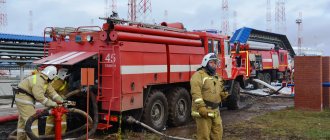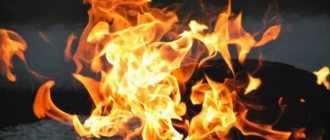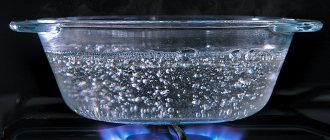Why can't gasoline be extinguished with water?
For everyone who works with gas, the topic of fire and fire is especially important. Therefore, our gas bloggers first of all care about safety, and then about hype. For example, everyone knows that a fire is always extinguished with water. However, if gasoline catches fire, water will not be suitable for extinguishing it. This will only intensify the fire and increase its area. Why?
Let's figure out why flaming objects are poured with water. The fact is that one of the conditions for the combustion process is the combination of a flammable substance with oxygen, so the main goal when extinguishing fires is to limit the flow of oxygen (air) to the burning object.
Extinguishing with water means blocking the access of oxygen to a burning object, since water, by wetting, envelops the burning object (and in addition, water reduces its temperature and cools it). This will not work with gasoline, because it does not mix with water, but simply floats to its surface (like vegetable oil), continuing to burn. At the same time, it will also begin to spread along with the water, increasing the area of the fire.
That is why gasoline should never be extinguished with water, but other methods must be used to block the access of air to it, for example, covering the ignited fuel with sand or earth. First, we fill the area around the fire with sand so that the fire does not spread, and then move towards its center. If you have a fire extinguisher nearby, you can safely use it, as modern fire extinguishers contain non-flammable powder that acts just like sand.
Source
Precautions when extinguishing
When extinguishing LV on your own, follow the rules to avoid injury and damage:
- do not start putting out a fire if you are wearing oily clothes or your hands are dirty with gasoline or other flammable liquid;
- When extinguishing a fire, make sure that there are no people within 10 meters of the fire;
- It is not recommended to extinguish the LV using water, this can lead to an explosion;
- It is advisable to extinguish LV fires in special clothing: hands should be protected with gloves, there should be no bare areas on the body.
Why can't gasoline be extinguished with water?
Can you imagine your life without fire? Hardly. If it had not existed, our ancestors would hardly have thought of eating meat after first frying or boiling it. Without it, we would not receive heat into our home, because the water coming through the pipes is heated by fire in 99% of cases. However, it can also play a cruel joke on a person - you can get burned by fire, entire houses burn down because of it... This, one might say, is the payment for the benefits of civilization to which we are all accustomed.
If there is a small fire, it is customary to extinguish the fire with water. This method is the most optimal and accessible. But you can’t extinguish gasoline with water. Why?
What is the combustion process? This is a chemical reaction as a result of which a flammable substance combines with oxygen, which is accompanied by the release of heat. The rate of this reaction depends on the ambient temperature and the area of contact of the combustible material with oxygen. By pouring water on the combustion site, we thus, firstly, lower its temperature, and secondly, block the access of oxygen to it. All this happens due to the properties of water.
But gasoline is a completely different matter. Not only does it not mix with water, but it is also lighter than it. If you start to extinguish it with water, the gasoline will begin to envelop the water droplets from the outside, as a result of which the area of contact of the flammable material with oxygen will only increase. This will increase the intensity of combustion.
What then should you do if there is a gasoline fire in or near your car? It is necessary to use a powder fire extinguisher, which should be in every car. Or, as one option, throw a non-flammable cloth (for example, asbestos) over the source of the fire, since thanks to this action you will stop the supply of oxygen to the fire. You can use ordinary river sand, but it is not always at hand.
Source
Pages
Questions can only be asked after registration. Please login or register.
The fuel, which is 99% pure water, burns an order of magnitude more intensely than conventional diesel fuel. The development used the principles of water structuring, changing the qualitative composition of a substance, and the principle of the transition of one substance to another. Scientists demonstrating how ordinary water burns say that the biblical miracle of turning water into wine was a miracle only for the people, but not for the author of the “miracle,” who knew real physics and which modern academics do not know. This project was submitted to the Ministry of Economic Development and approved by G. Gref, but for obvious reasons it was not given progress and is not being given. Here is the website https://kolohost.ru/?p=897, where you can watch the video!! Now the fuel crisis does not threaten us!
I couldn't watch it to the end. Even in Soviet times, water was added to fuel oil directly in front of the combustion chamber (boiler) - the water evaporating (from the high temperature) additionally atomized the fuel, resulting in better combustion and other benefits. Any petroleum fuel is lighter than water, and when combined with water they form an emulsion (which eventually separates into its components). Maybe the authors came up with some kind of emulsifier. but it's still nonsense.
It seems to me that no one will want to pour this water into their breadwinner until someone tries it, tells it and shows it to others. How does it affect the operation of the engine, the service life of the engine
otherwise “diesels worked for three years” but nothing specifically
I won’t say anything about 99% of water, but for 10-15 my parent poured 24 on the Volga and it was fine, but he didn’t drive in the winter, but I ride all year round, and once in the cold I had a joke, I started the car for 5 hours straight . And then I remembered about supercharging for water, warmed up the tube and started it with a dead battery, and swore off driving in winter with water. But acetone for gasoline, for a 55 liter tank you only need 250g, this is a real increase in power, for those who drive domestic cars, try it, you won’t be disappointed.
And here is a booklet on this topic Files: 1.doc
end Files: 4.doc
I have been interested in this topic for a long time. I supplied water to my 2107. True, apparently the rings were worn out. “sour cream” began to appear on the dipstick, so I stopped. But I passed the gases from the breather through the water and then into the air vent through a standard hose. I really liked this. Just drain the water every day and add fresh water.
I watched the video clip and repeated their experience. Happened. I won the argument with the observers. But!! I decided to move on. According to these “professors,” up to 50% of the fuel can be mixed with water. Made. Stir and give the mixture time to stand. In 10 minutes. in the bottle it was clearly visible where the water was and where the diesel fuel was. Naturally, there was no point in soaking the paper in solarium and setting it on fire. So I turned the bottle upside down, let it sit, and then carefully opened the cap and wet the paper. Naturally, wet paper does not burn. Accordingly, there can be no talk of changing the structure of water. After thinking about it, he swirled the contents of the bottle and immediately put the paper in it and, taking it out, began to set it on fire - it did not burn, however. The trick of these weirdos seems simple. Having dropped a gram of solarium into a bottle and shaken it, you definitely need time to settle. During this time, the solarium rises to the surface and forms a thin film that is practically invisible. But when you put paper into a bottle and while pulling it out, a very thin film sticks to the surface of the paper, which, when ignited, ignites. I guess so. Maybe someone can explain it differently?
We examine in detail the reasons why oil fires cannot be extinguished with water.
Fire is like a disease - it is better to prevent it than to fight it later. Fire safety of the premises is ensured by strict compliance with the requirements of fire safety rules and instructions.
If a fire does occur, there is no need to try to extinguish it yourself, unless this is the very beginning. After all, a fire, in essence, is the result of contact of ignition sources with various flammable substances and materials, and the choice of fire extinguishing means depends on the type of ignited substance. Therefore, before going to a fire fighting equipment store, it is worth familiarizing yourself with which extinguishing method will be the most rational in a given situation.
Reasons why burning oil and its derivatives cannot be extinguished by conventional methods
The combustion of petroleum products occurs for the same reasons as the combustion of any other flammable material. An accidental spark, a thrown cigarette butt or match, a short circuit in the electrical wiring, as well as any other sources of fire - and the flammable petroleum materials stored there will catch fire in the warehouse. It is accompanied by a bright and beautiful flame that burns for a long time.
However, extinguishing such burning products requires an unconventional approach. Wood or other flammable material can be extinguished with ordinary water, but in the case of petroleum products this is not applicable.
Why? Let's remember the elementary school physics course.
The density of oil and its derivatives is significantly lower than the similar value for H2O. In this regard, obeying physical laws, the water that is poured onto a burning oil slick simply sinks into the lower layers, without in any way interacting with the source of the fire.
Oil products float to the surface and continue to burn.
In many cases, such extinguishing even increases the area of the burning oil slick, since ordinary H2O begins to spread to the sides, and the burning oily liquid spreads along with it.
This can almost double the combustion area in a very short time.
It is best to extinguish fires of oil and products made from it using air-mechanical foam.
If the fire area is small, you can use a car powder fire extinguisher. If you still need to use water, it should only be in a finely dispersed (sprayed) form, but not in the form of a stream.
Another option that can be used to extinguish an oil fire is mechanical extinguishing. However, this method is only suitable for small areas of the burning spot. The essence of mechanical extinguishing is to deprive the fire of its main “food” - oxygen.
For this purpose, take a piece of tarpaulin or any other dense fabric (for example, asbestos or made from coarse wool) and cover the fire source with it. In this case, you need to clap the fabric, as if you were shaking out a rug, and the more intensely, the better.
When extinguishing such fires, increased precautions should be taken, since water particles, which are present in any petroleum product, can pose a serious danger. The thing is that when the combustion temperature is compared with the boiling point of water (100 degrees Celsius), suspended water particles begin to boil. As a result, hot fuel begins to shoot out to the sides.
This process usually begins about an hour after the fire starts, so it is best to extinguish the fire during this time.
Why can't a gasoline fire be extinguished with water? Now let's look at this issue. But let's first find out what gasoline is. This is a liquid that can burn on its own even after you remove the ignition source from it. Flash point: no more than 61 °C. But unlike most other liquids, burning gasoline should never be doused with water. And all because this may lead to an increase in the combustion area.
Fire hazard of flammable liquids
Flammable liquids include substances with a low flash point (oil, acetone, kerosene, gasoline, etc.), which ignite in a matter of seconds. The danger of flammable liquids lies in their ability to maintain the combustion process after removing the ignition source. At any time of the year and at any air temperature, the slightest spark caught in such a substance can cause ignition.
Petrol
Refers to flammable liquids.
There are different types of gasoline brands:
The conditions and purpose of their use vary.
| Gasoline brands | Flash point, ℃ | Self-ignition temperature, ℃ | Ignition area by volume, % | Ignition temperature limits, ℃ |
| Aviation | from –34 to –38 | 380–475 | 0,99–5,48 | from –38 to +5 |
| Automotive | from –27 to –39 | 255–370 | 0,76–5,16 | from –39 to –8 |
Kerosene
This flammable substance can cause an explosion when heated above 37 degrees. The fire spreads rapidly if extinguishing is not started in time. Eliminate the source of fire with powder fire extinguishers. The substance irritates the nasopharynx and skin, so when extinguishing fires, rescuers must wear protective gloves and masks.
Fire conditions
Since fire is a chemical reaction, like any reaction, it requires certain conditions for its occurrence and maintenance. In particular, the following 4 conditions are necessary for the existence of fire:
- Fuel or combustible substance, that is, any substance that can burn.
- An oxidizing agent, that is, a component of a chemical reaction that has oxidizing properties. In the case of fire, as a rule, oxygen in the air acts as an oxidizing agent.
- Heat, that is, the energy that is necessary for the fuel and oxidizer to begin to enter into a chemical reaction in a certain place and at a certain time.
- To maintain a fire in a stable state, it is necessary for the chemical combustion reaction to proceed in a chain manner.
When the combustion process begins, the heat generated creates the conditions for the process to continue, and as long as the fuel and oxidizer exist, the fire will not go out.
How to overcome it?
How to extinguish gasoline? To put it out, you will need to cut off its oxygen supply in another way. It is better to cover the flame with earth or sand. If the fire is growing slowly, first try to cover everything around it so that it does not start to spread further. If a container of gasoline catches fire, then these methods are not suitable. Here you need to act differently - cover the container with a cloth (the denser the better).
Water is usually used to extinguish burning wood, textiles, paper, i.e. solid substances. When igniting liquid flammable substances, such as gasoline and other petroleum products that are insoluble in water, water is used only with the addition of fluorinated surfactants.
In the event of a fire in household gas or other gaseous substances, water can only be used to cool the equipment.
Do not use water when extinguishing burning metal-containing compounds, alkali metals such as sodium, potassium. These substances enter into a chemical reaction with water, which results in the release of heat, which will further aggravate the situation. In this case, the only acceptable method is extinguishing with special powders. It is also prohibited to use water in the event of a fire in electrical equipment or electrical wiring. Therefore, do not rush to use fire hoses in case of fire: the cost of a mistake can be very expensive.
Why does water put out fire?
Knowing the conditions under which fire exists, you can understand what needs to be done to extinguish it. As for water, first of all it should be said that water and fire are absolutely incompatible things. Since water cannot burn (the water molecule is chemically oxidized hydrogen), it is a natural fire extinguisher. Why does water put out fire? From a physics point of view, the following reasons can be cited:
- Upon contact with a flammable substance, water turns into steam, taking away a large amount of heat and cooling the flammable material.
- Streams of water vapor enveloping the fuel make it difficult for oxygen to penetrate it.
- Water makes the combustible material wet, thereby isolating it from open fire, which prevents the combustion process from sustaining. This is why when fuel, such as wood, is wet, it cannot be ignited.
Is it possible to light a puddle of gasoline with a cigarette thrown into it?
Connoisseurs of Hollywood action films have probably seen a plot in which a movie character set fire to spilled gasoline with a smoldering cigarette.
Is it scientifically possible to repeat this trick in real life?
Combustion Features
Contrary to popular belief, it is not gasoline itself that burns, but gasoline vapor.
The fire hazardous concentration of vapors in the air ranges from 1 to 6%. If there are fewer gases, then there will not be enough fuel for combustion; if there are more, then the exothermic reaction will be impossible due to lack of oxygen.
Gasoline begins to emit flammable vapors at –40°C, and therefore, in theory, automotive fuel is almost always explosive. A small spark is enough for a volatile liquid to ignite.
Interestingly, the flash point of diesel fuel is +62°C. Diesel fuel is a heavy fuel with a long carbon chain and low volatility. Such fuel does not evaporate well, and therefore it will not be possible to ignite it with a random spark.
What other ways are there to fight?
We have figured out why burning gasoline cannot be extinguished with water, now let's first briefly look at the methods that will really help in solving this problem. Then we will describe how to act in this case.
In order to put out gasoline, as we have already found out, you need to block the access of oxygen to the object that caught fire, since without it it will not burn. You can use a fire extinguisher for this. Which fire extinguisher should you use to put out gasoline? For flammable liquids, powder is suitable.
How to put out a burning canister?
You can extinguish a fire with sand or earth only if the liquid is spilled on the floor or ground. But if a container of gasoline catches fire, it can cause harm. Never throw soil or sand onto the canister to avoid accidentally knocking over or spilling its contents. Thick fabric (for example, a rug, coat, bedspread, etc.) is better suited in such a situation. Cover the container, this will help block air access to it. Do not open this canister until it stops burning.
How to extinguish gasoline with sand or earth
In order to extinguish a fire in this way, it should be generously covered with whatever is closest - sand or earth. Moreover, this should be done carefully, since flying burning drops can ignite nearby objects. Of course, before you begin to extinguish flammable liquids, if possible, you need to clear the surrounding area of flammable objects in order to prevent their possible ignition.
Before starting extinguishing, it is advisable to block the possibility of spilling the burning liquid - fill it with sand around the perimeter. After completing such an operation, the sand becomes toxic, so it should be removed away from residential buildings or playgrounds - buried in a deserted place. We should not forget about smoldering objects - they can easily breathe a second life into a seemingly extinguished fire.
However, sand and earth can sometimes be ineffective in dealing with fire. When a kerosene stove is burning, extinguishing it with sand will not only not help, but can also lead to much more serious consequences: the burning kerosene stove may tip over, thereby increasing the volume of the fire. The most effective way to extinguish in this case is with a thick cloth: a rug, a coat, etc. This blocks the access of oxygen and the fire goes out. The same principle must be followed when a flammable liquid ignites in an open volume, for example in
Source
Instructions
Carefully cover fire spots with earth or sand so that gasoline does not spill, splash, or get on nearby objects, otherwise the fire will engulf them too. But before you do anything, remove to a safe distance all things that can catch fire and are close to the fire (furniture, curtains, etc.).
Then you will need to sprinkle sand or earth around the burning liquid. Next, fill from the edges to the middle. Once you have extinguished the fire, the sand (used to extinguish the fire) becomes toxic, so it will need to be buried away from public areas and areas where there are plants.
Remember that if you have already been able to put out the fire, it can easily start again. This can happen if there are burning objects or objects that are still smoldering nearby. Vapors from such a fire can also catch fire. Check all areas well and correct any problems.











